Eurythmy as Visible Speech
GA 279
X. Movements Arising Out of the Being of Man
7 July 1924, Dornach
Up to this point we have, at least to some extent, derived the eurhythmic gestures from the actual sounds of speech. Now we must realize that everything which may be expressed through the medium of these gestures—and which is therefore in a certain sense the revelation of man himself, just as the spoken word is also a revelation of man himself—we must realize that all this is based upon the possibilities of form and movement inherent in the human organism. For this reason we may choose yet another starting-point; we may, that is to say, take the nature of man himself and develop from this the various possibilities of form and movement. We may see what manner of movement can proceed out of the human organism; and then, carrying this further, we may eventually discover how the individual movement can take on the character of the visible sound.
Today, in the first place, we will take our start from the actual being of man, and we will endeavour to discover the forms and movements that may arise in this way. Then, proceeding somewhat further, we shall ask ourselves: Which sound is to be regarded as related to this or that particular movement?
For this purpose I shall need quite a number of eurhythmists, and I will therefore ask them to come on to the stage.
Will you place yourselves in a circle in such a way as to have equal distances between each point?
I. Raise both arms upwards, the palms of the hands turned outwards and all the fingers widely spread.
II. Hold the right arm closely to the body, the left hand being lightly supported against the side.
III. Both arms stretched forwards, the one laid over the other.
IV. The arms held to the sides, the left arm at some distance from the body.
V. One foot placed forwards, the left hand grasping the right elbow.
VI. Close the left hand into a fist and place it against the forehead; with the other hand, which is held
more in a forward direction make this gesture. (See diagram VI.)
VII. Both hands forwards, the left hand below, the right above.
VIII. Stand with the weight on the left foot, holding the right foot slightly raised, the right hand upwards in a vertical position, and the left arm bent somewhat sideways.
IX. Bend the head forwards and downwards, touching the chin with the right hand, and allowing the left hand to hang at the side.
X. Clasp the right arm over the head, covering the larynx with the left hand.
XI. Place the feet so that they are turned inwards and cross the arms.
XII. Left arm placed against the breast, the right arm against the back.
Here you see a series of gestures. These gestures in their totality represent the entire human being—the human being split up, as it were, into twelve separate elements, but still the entire human being.
You might also imagine these gestures being carried out by a single person, one after the other. If you picture them being made one after the other by the same person, you would see still more clearly how in this way, when one individual makes all the movements, the whole being of man is revealed and expressed with quite remarkable force and clarity.
Let us now pass through these several aspects of the human being. We will begin here: (gesture IV - Scorpio):
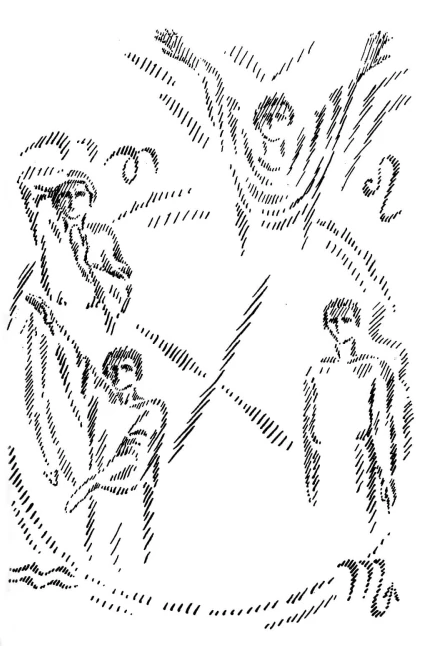
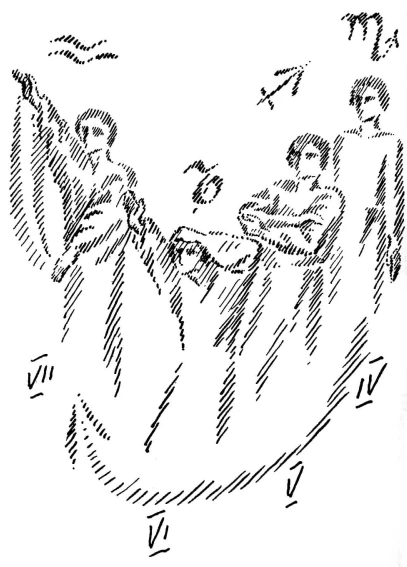

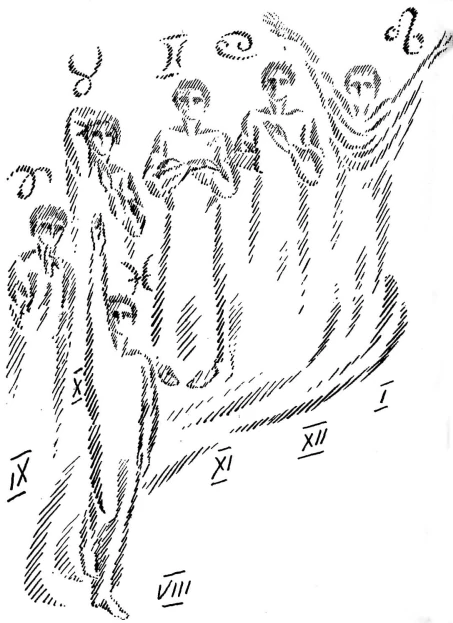
Try to imagine that we here have represented that element in the human being, which we call the intellect, the mind. We must realize that this gesture is the expression of the understanding, the intellect.
Now let us look at this: (gesture I -Leo):
From this gesture, there streams out with a sunny radiance that element which may be described as enthusiasm, which has its source in the breast. Thus we may say: gesture IV—the head: gesture I—the breast, enthusiasm.
Now let us pass to this point: (gesture X)
Here, the head is enfolded by the right arm, while the left hand covers the larynx. In this gesture we have represented that part of the human being that is the expression of the will. (The Word is silenced). We have man as the representative of the will, of all that can lead to action, to deed. Thus we may say: the limb system, will, deed.
Fundamentally speaking we now really have before us the threefold organism of human nature: understanding, feeling, will.
Then we still have that gesture which synthesizes all these elements in itself. You can see how here, in this gesture, there is the striving after balance: (gesture VII - Aquarius):
A state of balance is sought between these various aspects. One may imagine that the arms move in this way (with an upward and downward movement) and that by this means one is endeavouring to experience this state of balance. Here we feel the whole human being seeking to obtain equilibrium; it is the representation of the human being who finds the perfect balance between his three forces—thinking, feeling and willing. I will only write ‘the human being in a state of balance’ (see diagram). You must take these descriptions which I am writing here as matters of the greatest significance.
Now we will go one stage further; when you pass over from the thinking human being to the human being as he seeks for equilibrium you have, lying between these two aspects, that element which follows after thought, which is the consequence of thinking. Where does thinking lead us? To resolve. Thus gesture V is the resolve, the thought that wishes to transfer itself into reality: Resolve (gesture V - Sagittarius):
Now we reach this point (gesture VI) [Capricorn - L]
We see from the very nature of this gesture that something exceedingly significant lies here. This gesture (IV) represents thought. Thought may be very clever, but it does not necessarily enter into reality; it does not necessarily reach the point of resolve. Here we have thought; but thought may always miscarry when it comes to a question of external matters. At this point (gesture VI) thought struggles with the conditions of the outer world: the bringing of thought into connection with the external world (see diagram). This connection of thought with the outer world must actually become part of the complete human being; for the man who has reached a state of balance can, as he goes his way through the world, only bring his deeds to fulfilment when he has first entered into a relationship with the outer world.
And now, starting from the understanding, we will take the other direction. What really happens before one formulates a thought? Something must lead over to the state of understanding and now, starting from the understanding, we will take the other direction. What is really standing before a thought is actually formulated, we have the state of hypothesis; we have a weighing, as it were, of the pros and cons of the matter. Thus here, in this gesture (gesture III), you see the weighing process in its relation to thought (see diagram): [Libra - TS]
But how does this weighing, balancing process come about? In this connection we must make an accurate study of gesture II. What lies behind this gesture? You will remember that we take as our starting-point, feeling, enthusiasm (gesture I). This is a ‘burning enthusiasm’ (the enthusiasm which we lack so greatly in our Society, but which at least is represented here). Now, passing from gesture I to gesture III, before we reach that quiet feeling of weighing or balancing, a reasonable soberness must first make its appearance (see diagram). Gesture II—Soberness. [Virgo - B]
You will be able to feel this quite easily if you enter into the gesture correctly and without prejudice.
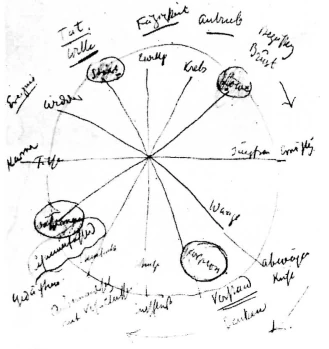
We have, then, that enthusiasm which has its seat in the, breast (gesture I). Now we come to this point: (gesture XII): [Cancer - F]
Here we have not yet reached enthusiasm, or rather, let us say, enthusiasm does not on this side pass over into a weighing, thoughtful process; it passes over into action, into the expression of will. On the path from enthusiasm to will, we find the first stage to be initiative, the going out of oneself, the impulse towards action. Enthusiasm burns with a fire that cannot endure. But when an action is to be accomplished there must be initiative, there must be the impulse towards action. Here then (gesture XII), we see the impulse towards action.
Now we must pass still further; let us observe the next stage. Here the whole human being is filled with the conviction that he will succeed in accomplishing the action: (gesture XI): [Gemini—H]
We can almost see Napoleon before us. Special attention, too, must here be paid to the use of the legs and feet; the eurhythmist must not stand as in the other positions, but with a firm hold on the ground. You will notice that admirals on board ship always stand in this way. (And let me here advise you, when you are on a ship, always to walk in this way; then you will not so easily feel the motion of the vessel, nor so easily become sea-sick.) This, then, is not merely initiative, but it is the capacity for action. Here (see diagram) we have already reached the capacity for action.
And now, with gesture X we have the action itself (see drawing R)
Then we go one stage further. When the action has been accomplished, what has been brought about by its means in the world outside man? We see the human being living in the world. He observes what has been brought about through his action. It is no longer a question of the action only. The human being has already passed beyond this; he can observe it; action has already become event—an event that has been brought about by his action, by his deed.
Thus in gesture IX we have the event (see diagram): [Aries V]
And now we pass on to gesture VIII: [Pisces - N]
In this gesture you can see that the event has made its impression upon the human being. He has caused something to happen and this happening has left its impression upon him; it has become destiny. Thus we may say (see diagram): Event has become destiny.
In this circle, then, we have the human being divided up into his component elements. We can picture this human being as containing within himself twelve elements and we can also discover the twelve corresponding gestures.
And now I need seven more eurhythmists. Let us start here in the centre: Stretch out the arms, the right arm forwards and the left arm backwards; and now you must move both arms simultaneously in a circular direction. (You need, however, only actually make this gesture when all the others have been told what to do.)
With this first gesture, which I have described, we have no longer merely the gesture which is held, but one which is in movement. And when we take this gesture, this movement, we find that it is the expression of the human being in his entirety.
Now the second: left arm backwards, right arm forwards; you must move the left arm in a circle, the right arm remaining quiescent.
Here we have shown you the second movement. It is the expression for all the loving, sacrificing qualities in the human being. Thus: the human being in his aspect of loving sacrifice (see diagram).
Now comes the third movement: right arm forwards, left arm backwards, the right arm moving in a circle. This is the extreme opposite of the preceding movement. It is the anti-thesis of the loving, sacrificing qualities. This is the aspect of egoism.
The fourth: stretch out the arms in front of you, with the lower arms crossed one above the other. This gesture is in the sphere of the spiritual; for this reason it may remain quiescent. Here we have everything in the human being that is creative; it is the capacity for creation.
Now we come to the fifth: you must hold the arms forwards with the fingers drawn inwards, and the movement is made by means of a rocking of the body, upwards and downwards. This represents the aggressive quality in the human being, thus the aggressive element.
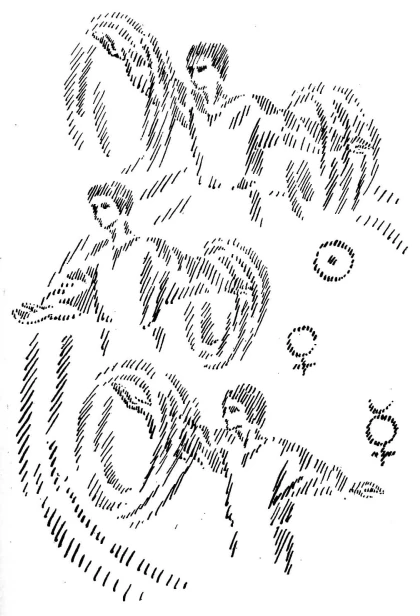
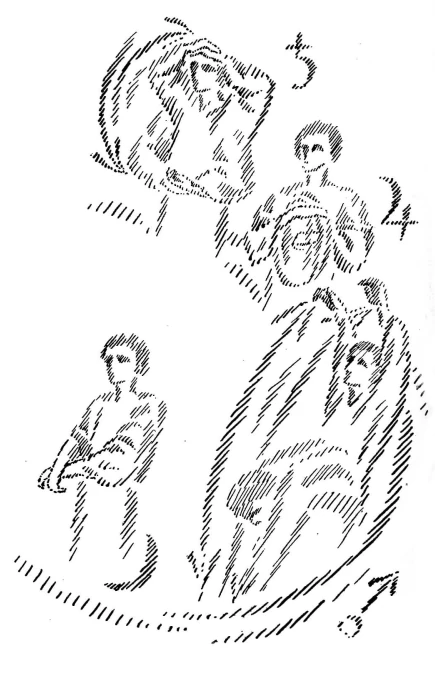
The sixth: you must hold the left arm still (bent inwards) while the right makes a circular movement around it. In this way we show clearly that we are not now expressing the aggressive element but the activity arising out of wisdom.
And now we have the last movement: Here the hands are laced against the forehead, the one somewhat over the other; now allow them to move smoothly up and down—and again, up and down. Make this gesture, this movement. Here we have the expression of everything that is most profound, the contemplative, meditative element. The human being is here turned in upon himself; I will describe it as deep contemplation (Tiefsinn).
Thus we have formed a large circle and also a small circle. In the outer and larger circle we have the twelve outer gestures, which are static, which express form; here in the inner circle we have seven figures which express movement, with one exception, that is to say. This gesture expresses a different aspect, namely movement that is brought to quiescence.
Now you will soon see what a harmonious effect is produced when all these postures and gestures are combined: those in the inner circle carry out the movements belonging to them, while those in the outer circle take up their postures.
We must, however, go still further: those in the inner circle make their movements; the outer figures move slowly in a circle from left to right, always holding their postures. During the whole time the others also must make their movements. Here, you see, it is as though the human being were observing the world from all sides, and bringing all his faculties and capacities into movement.
Will you once again take up your postures and form the outer circle? I must just mention that in eurhythmy the direction from left to right is really reversed (that is to say it is taken from the point of view of the audience); this also applies to the direction from right to left. The outer circle moves at a moderate pace from left to right; those in the inner circle, still making their gestures, move round somewhat more rapidly. Thus the inner circle dances round at a rapid pace, the outer circle dances round more slowly. Now add all the movements and gestures. See what a harmonious effect is produced! This is one possibility. Here we have a first attempt at drawing forth from the organism its inherent possibilities of movement and gesture; and we can do this when at the same time we bear in mind the human being in his entirety. And we can indeed see how, in the future, further possibilities of form and movement will gradually be able to develop from out of this element.
In very truth the human being has not grown up simply from those forces known and recognized by present day science. He has grown up out of the whole cosmos and his nature may only be understood when the whole cosmos is taken into consideration.
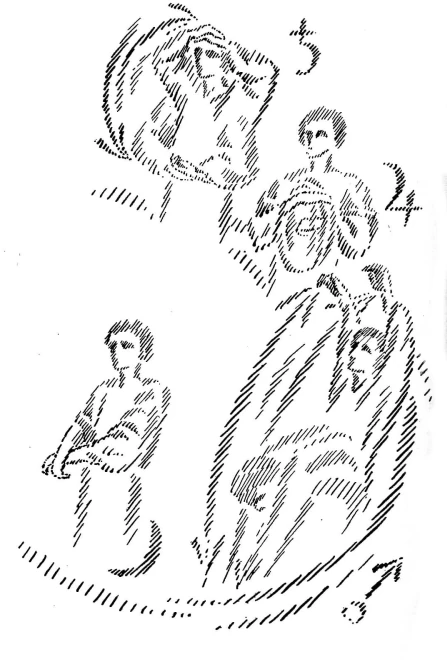
When we have taken all that we have just seen and really observe it closely, then we may say that we have before us the human being divided up into all his different faculties, into the various qualities and forces of his being.
But, in the outer world, the human being is always divided up into the various members of his being. This is to be seen in the animals. The human being bears within him all the faculties of the principal animals. These are gathered together in him, synthesized and raised to a higher level.
Thus we have in the first place the four main animal types. Here we have enthusiasm, the breast element—Leo, the lion (see diagram). The lion has as its dominant characteristic what we have here in this, its corresponding gesture (I).
Further: Here (X) is that element which is manifested in the outer world in everything standing under the sign of external action, under the sign of the will: Taurus, the bull (see diagram).
Then here (VII), you have that which seeks to blend in the human being as a whole all the elements of experience, of action: you saw this in the way the movement was shown. Here we have that which welds together all the separated qualities, just as the etheric body welds together all the different members of the physical body. At one time the etheric man was also called the ‘Water Man’. Here (see diagram) one really ought to write: The Etheric Man. According to ancient designation however, this is also the ‘Water Man’—so here I may justifiably write: Aquarius, the Water Man. You now know that this signifies the etheric man.
Then we have the fascinating quality of cleverness, of brains, that which creates an impression (IV). And it is just here that tradition has brought about a gross error. In reality this has to do with all that is connected with the innermost organization of the head. So that I ought really to write: the eagle. This confusion between the eagle and the scorpion seems, however, only to have arisen in comparatively recent times. Here then, we must picture the eagle (see diagram). But everywhere today we shall find this sign designated as Scorpio. (I do not necessarily mean to imply that people have gradually learned to regard the understanding as something that stings them!)
Now we have here the four main characteristics of the human being. The others lie in the intervening spaces; enthusiasm does not immediately pass over into action; something lies between; At this point we have initiative. This impulse, which leads us over from enthusiasm to activity, which takes us out of ourselves, is incorporated in the feeling system, in that part of the human being that is enclosed by the ribs. In the ancient language of physiology this part of the organism was designated as ‘the crab’. Here also, then, I may call this point Cancer, the crab (see diagram). In the zoology of earlier times the word ‘crab’ did not merely signify that animal which we today call the crab; it signified all those animals possessing a specially strongly developed rib-organization. This is what was originally meant by the word ‘crab’. Everything, which had a special development of the ribs, was ‘a crab’.
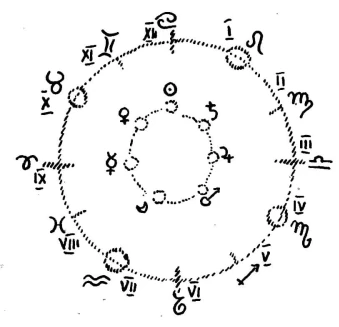
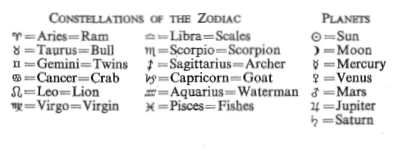
Now when the human being wishes to pass over into the sphere of action he must be able to move properly; he must bring both sides of his organism into a properly balanced movement. Thus the element of left and right in the human being must be brought into action in a harmonious manner. Here we must observe that type of animal that is so organized that it has continually to bring the left and right sides of its organism into a synthetic and harmonious movement. Some animals, when walking or running, have to do this to a very marked degree: Gemini, the twins (XI) (see diagram).
As I said, from here we pass on to the action, and from the action to the event. When we examine this transition from the action to the event we find, in the animal kingdom, that it is best symbolized by those animals having curved horns. This brings us to the event: Aries, the ram (IX). Naturally, I should have to speak at considerable length if I wished fully to justify this statement.
Then we go further and reach the point where the human being is merged in the external world, where he gives himself up to the external world; we come to the point where his action becomes destiny. Here the human being lives in the moral element as the fish lives in water. As the fish is merged in the water in which it swims, almost becoming one with it, so does the human being live with his destiny in a moral outer world. Thus: Pisces, the fish (VIII).
Now I have already said that one must find a gradual transition from enthusiasm to quiet thought. We find this transition when the burning enthusiasm becomes sobered. The cooling element, that element which has not yet caught fire, when embodied in the animal kingdom, was called in ancient times: Virgo (II) (see diagram).
And after this soberness comes the quiet, weighing process, the balancing: Libra, the balances. Those animals that seem to consider everything were, in the dim past, designated as the balances (see diagram).
Now we pass from IV to VII, from Scorpio, or more properly the eagle, to Aquarius, to the etheric man. First we have the resolve, where thought determines to make itself felt in the outer world. It is easy to see why certain animals which dart from place to place from a certain nervousness of disposition - as for instance, certain woodland animals - it is easy to see why in ancient times such animals were named ‘Archers’. This is something different from what was later supposed; it is simply a characteristic of certain animals: Sagittarius, the archer (V) (see diagram). (Today, even, I believe that in certain dialects the expression ‘Schutze’ (archers) is used for those wretched little insects that dart about in the kitchen regions.)
And now we come to the bringing of thought into relationship with the world. At this stage, where one butts at everything - where one has not yet achieved the blending of all the human qualities nor reached as yet the sphere of destiny - at this stage we have the goat. Thus here I must write (VI): Capricorn, the goat. Man in his entirety is summed up in the circle of the Zodiac. But all this must be regarded as expressing human qualities and faculties, and these human qualities again make their appearance in the postures we have been studying.
Now in the inner circle we have had the expression of the human being as a whole: Sun. Next we passed over to the human being in his aspect of loving sacrifice: Venus; then to the more egotistical aspect: Mercury; to the creative, productive aspect: Moon; to the aggressive aspect: Mars; and then to the aspect of wisdom in the human being, that which radiates wisdom: Jupiter. And finally, we have that which passes over into a certain melancholy, into an inner contemplation, into a profound inwardness: Saturn (see diagram).
As we enter the sphere that reveals the human being to us in the way I have just described, we pass over from the postures that are held, to the gestures which are in movement. And if we now wish to synthesize all this, to gather it together into a single whole, we can do so in the way I have shown you, by bringing the circle into movement. By so doing we externalise all that which together makes up the complete human being, that is to say, the synthesis of all the animal qualities, the animal characteristics.
A certain experiment is given in the ‘Colour Teaching’ of Goethe: here one paints a disc in sections according to the seven colours—red, orange, yellow, green, blue, violet, etc., then one brings the whole thing into movement, whirling it ever faster and faster until the whole impression is grey. The physicists assert: white—it is however, not white, but grey. The separate colours can no longer be distinguished; everything appears as grey.
Now if the eurhythmists had moved with such rapidity that the separate gestures were no more to be seen, but all were whirled together into a whole, then you would have seen some-thing of extraordinary interest: the picture of the human being expressed through his own movements.
Here (in the inner planetary circle) you have all those qualities in the human being which tend outwards, those possibilities of inner activity whereby the animal nature is gradually led over into the human. Thus, in the outer circle we have: all the animals as man; and here, in the inner circle, we have: a synthesis of the animal qualities transmuted into the human by means of the sevenfold planetary influence.
And now I must ask you (the details I shall give you next time) to bear in mind the sounds: a, e, i, o, u, ei, au—seven vowels. When we take the consonants really according to their innermost nature, grouping those letters together that are somewhat similar in sound, we get the twelve consonants. Thus we have twelve consonants and seven vowels. We arrive at the nineteen possibilities of sound when we see the consonantal element in the Zodiac, and the vowel element in the moving circle of the planets. This is the language of the heavens; whenever a planet stands between two signs of the Zodiac, in reality a vowel is standing between two consonants. The constellations arising through the motions of the planets are indeed a heavenly utterance that sounds forth with infinite variety. And that which is here uttered is the being of man. Small wonder, then, that in the possibilities of gesture and movement the cosmos itself is brought to expression.
Such thoughts as these enable us to realize that in eurhythmy we are really reviving the temple dancing of the ancient Mysteries, the reflection of the dance of the stars, the reflection of the utterances of the gods in heaven to human beings below upon the earth. It is only necessary, by means of spiritual perception, to find once again in our age the possibility of discovering the inner meaning of the gestures in question.
Today, then, we have discovered nineteen gestures; twelve static, and seven permeated with movement—of which latter one is quiescent only because rest is the antithesis of movement. (In the Moon we have movement annulled by its very velocity.)
Thus we have learned to know these gestures, and I have also been able to indicate how they lead over into the realm of sound.
Here we have taken the human being as our starting point and have travelled the opposite path. Previously we started from the sounds; now we take our start from the possibilities of movement and follow this path till it leads to man, to a visible language, to the sounds themselves.

